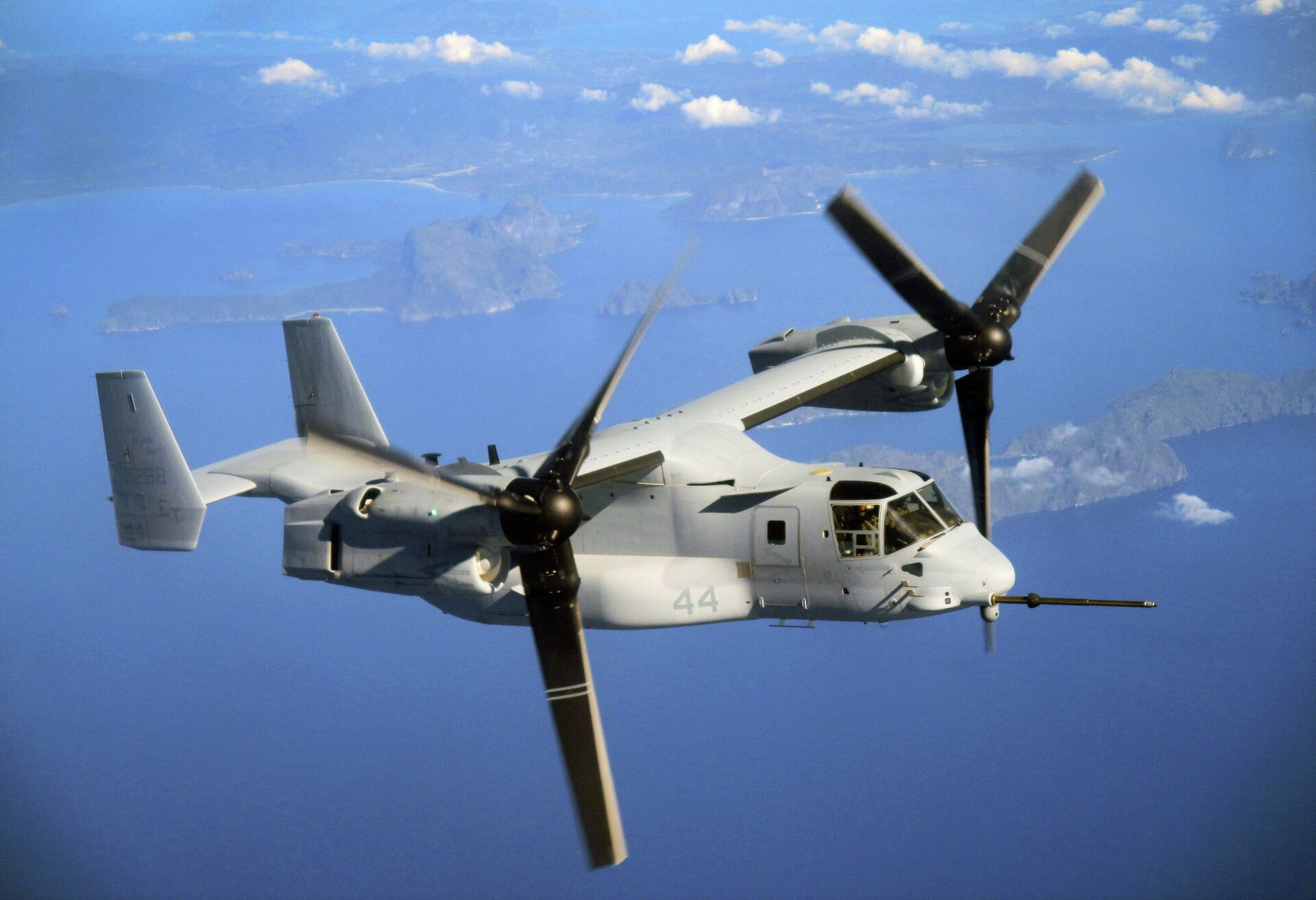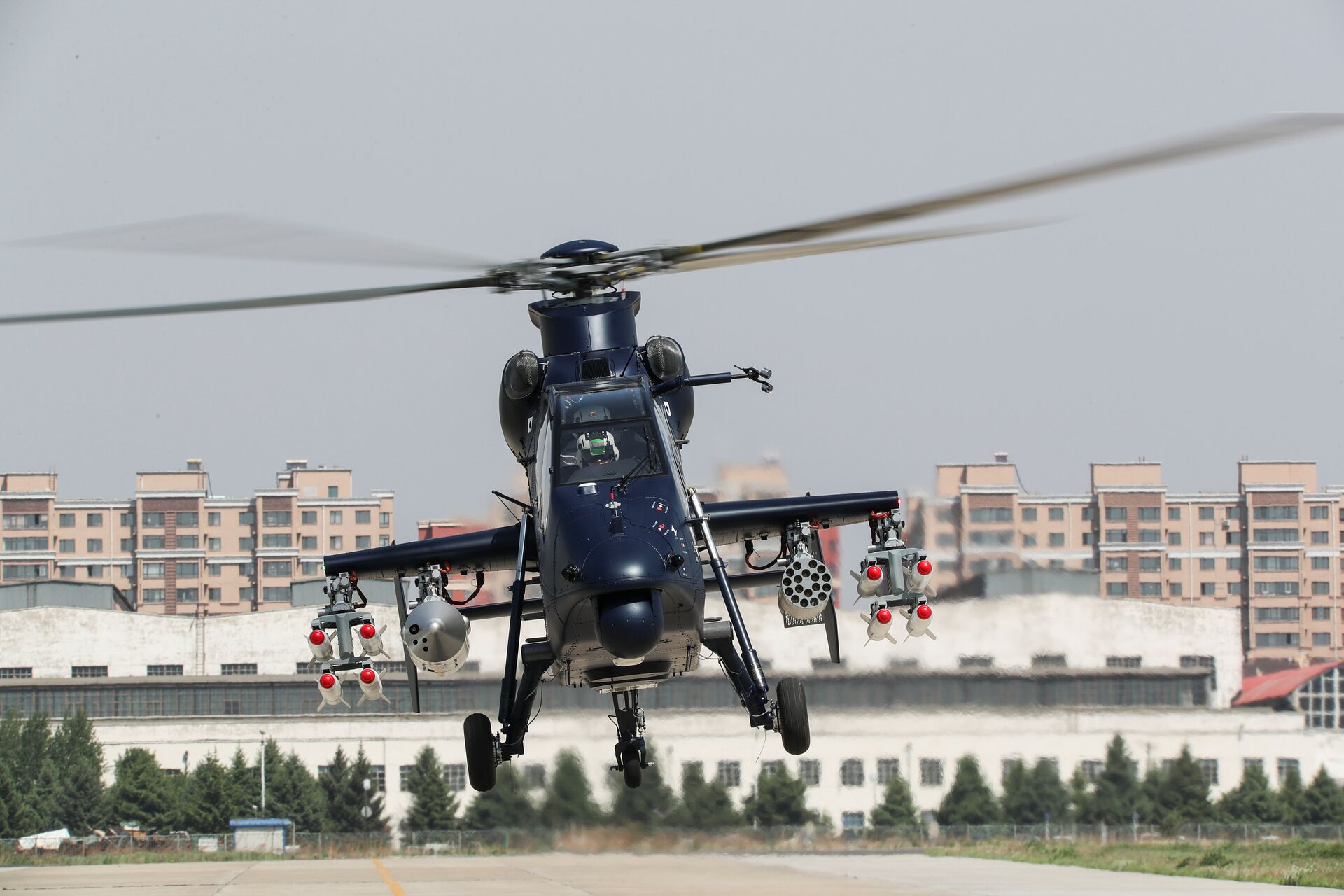https://sputnikglobe.com/20220419/high-speed-ai-trends-for-future-helicopters-chinese-attack-chopper-designer-1094884956.html
High Speed, AI Trends for Future Helicopters: Chinese Attack Chopper Designer
High Speed, AI Trends for Future Helicopters: Chinese Attack Chopper Designer
Sputnik International
High Speed, AI Trends for Future Helicopters: Chinese Attack Chopper Designer
2022-04-19T11:10+0000
2022-04-19T11:10+0000
2022-04-19T11:10+0000
asia
china
helicopter
helicopters
https://cdn1.img.sputnikglobe.com/img/102725/75/1027257581_0:0:2048:1153_1920x0_80_0_0_5fd17909399d2921db2a56607b2f9f42.jpg
The world has made concrete steps in the development and application of high-speed rotorcraft, with the US commissioning the V-22 Osprey tilt-rotor transport aircraft and conducting test flights for the S-97 Raider and SB-1 Defiant helicopters. Within 10 years, it will be the norm for helicopters, or rotorcraft in general, to feature high speeds, Wu Ximing, deputy head of the Chinese Aeronautical Establishment, said during the lecture organised by the China Science and Technology Museum on Sunday.Unlike the traditional configuration of previous helicopters, the new ones will have very different designs, including those that were made to break the physical speed limit of about 300 kilometers an hour restricted by the traditional design, said Wu, who is also the chief designer of the Z-10, the main battle attack helicopter used by the Chinese military.It will require exploration and innovation by helicopter designers to achieve high speeds while maintaining the vertical takeoff and landing capabilities, Wu said.Since Wu gave a general time frame of 10 years for most helicopters to achieve high speed, it can be expected that China could also reveal its high-speed helicopters within 10 years, a Chinese military expert told the Global Times on Monday, requesting anonymity.China's helicopter makers have reportedly conducted test flights for at least two types of helicopters with innovative designs: one is a blended-wing body multi-rotor vertical takeoff and landing aircraft, the other is a helicopter with a completely different, innovative design.Helicopters will also be empowered by AI, and this means that a digital helmet or screen could replace the control levers on a helicopter, as AI could understand voice commands from the pilot, give suggestions on flight routes, or even make independent decisions under harsh environments or in complex missions, Wu said.AI will enable the intelligent flight of a single helicopter, the coordinated flight of multiple helicopters, and the autonomous carrying out of missions, according to Wu's presentation.With the rapid development of information technologies like 5G and 6G, it is possible that the helicopter could get larger computing capacity from ground-based systems through a network, and this could optimise the helicopter's capabilities and enhance its efficiency, Wu said.The use of AI will apply not only to helicopters, but also to aircraft in general, including fighter jets, the anonymous expert said.The development of drones is another future trend for helicopters, as drones do not lead to casualties. They are not restricted by a human pilot's physical limits and can be used in harsh environments, Wu pointed out, while they cost less and offer higher survivability.Miniature drone helicopters are also a viable option in missions like tactical reconnaissance, as they are easy to carry and can penetrate hostile defenses stealthily, Wu said.China has developed a type of portable reconnaissance drone helicopter dubbed the Hummingbird, which is only 15 centimeters long and weighs only 35 grams, China Central Television reported in February.This article was originally published by the Global Times.
china
Sputnik International
feedback@sputniknews.com
+74956456601
MIA „Rossiya Segodnya“
2022
Sputnik International
feedback@sputniknews.com
+74956456601
MIA „Rossiya Segodnya“
News
en_EN
Sputnik International
feedback@sputniknews.com
+74956456601
MIA „Rossiya Segodnya“
Sputnik International
feedback@sputniknews.com
+74956456601
MIA „Rossiya Segodnya“
high speed, ai trends for future helicopters: chinese attack chopper designer
high speed, ai trends for future helicopters: chinese attack chopper designer
High Speed, AI Trends for Future Helicopters: Chinese Attack Chopper Designer
High speeds and artificial intelligence (AI) are among the trends in the development of future helicopters, a top Chinese military helicopter designer said during a recent public lecture, giving a glimpse into the possibilities of the country's next-generation choppers, which could feature completely new designs and configurations.
The world has made concrete steps in the development and application of high-speed rotorcraft, with the US commissioning the V-22 Osprey tilt-rotor transport aircraft and conducting test flights for the S-97 Raider and SB-1 Defiant helicopters. Within 10 years, it will be the norm for helicopters, or rotorcraft in general, to feature high speeds, Wu Ximing, deputy head of the Chinese Aeronautical Establishment, said during the lecture organised by the China Science and Technology Museum on Sunday.
Unlike the traditional configuration of previous helicopters, the new ones will have very different designs, including those that were made to break the physical speed limit of about 300 kilometers an hour restricted by the traditional design, said Wu, who is also the chief designer of the Z-10, the main battle attack helicopter used by the Chinese military.
It will require exploration and innovation by helicopter designers to achieve high speeds while maintaining the vertical takeoff and landing capabilities, Wu said.
Since Wu gave a general time frame of 10 years for most helicopters to achieve high speed, it can be expected that China could also reveal its high-speed helicopters within 10 years, a Chinese military expert told the Global Times on Monday, requesting anonymity.
China's helicopter makers have reportedly conducted test flights for at least two types of helicopters with innovative designs: one is a blended-wing body
multi-rotor vertical takeoff and landing aircraft, the other is a helicopter with a completely different,
innovative design.
Helicopters will also be empowered by AI, and this means that a digital helmet or screen could replace the control levers on a helicopter, as AI could understand voice commands from the pilot, give suggestions on flight routes, or even make independent decisions under harsh environments or in complex missions, Wu said.
"Intelligent technologies will greatly reduce the workload of the pilot in flying the chopper".
AI will enable the intelligent flight of a single helicopter, the coordinated flight of multiple helicopters, and the autonomous carrying out of missions, according to Wu's presentation.
With the rapid development of information technologies like 5G and 6G, it is possible that the helicopter could get larger computing capacity from ground-based systems through a network, and this could optimise the helicopter's capabilities and enhance its efficiency, Wu said.
The use of AI will apply not only to helicopters, but also to aircraft in general, including fighter jets, the anonymous expert said.
The development of drones is another future trend for helicopters, as drones do not lead to casualties. They are not restricted by a human pilot's physical limits and can be used in harsh environments, Wu pointed out, while they cost less and offer higher survivability.
Miniature drone helicopters are also a viable option in missions like tactical reconnaissance, as they are easy to carry and can penetrate hostile defenses stealthily, Wu said.
China has developed a type of portable reconnaissance drone helicopter dubbed the Hummingbird, which is only 15 centimeters long and weighs only 35 grams, China Central Television reported in February.
This article was originally published by the Global Times.




